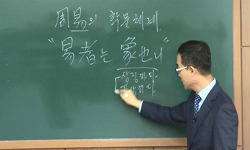오징의 『역찬언외익(易纂言外翼)』의 『주역(周易)』 해석 방법론 중에서 『주역(周易)』의 괘효사를 해석하는 데 있어서 주요한 방법론은 괘변(卦變), 변괘(變卦), 호괘(互卦)이다. 괘변(卦...
http://chineseinput.net/에서 pinyin(병음)방식으로 중국어를 변환할 수 있습니다.
변환된 중국어를 복사하여 사용하시면 됩니다.
- 中文 을 입력하시려면 zhongwen을 입력하시고 space를누르시면됩니다.
- 北京 을 입력하시려면 beijing을 입력하시고 space를 누르시면 됩니다.
https://www.riss.kr/link?id=A103119957
- 저자
- 발행기관
- 학술지명
- 권호사항
-
발행연도
2017
-
작성언어
Korean
- 주제어
-
등재정보
KCI등재
-
자료형태
학술저널
-
수록면
183-222(40쪽)
- DOI식별코드
- 제공처
-
0
상세조회 -
0
다운로드
부가정보
국문 초록 (Abstract)
오징의 『역찬언외익(易纂言外翼)』의 『주역(周易)』 해석 방법론 중에서 『주역(周易)』의 괘효사를 해석하는 데 있어서 주요한 방법론은 괘변(卦變), 변괘(變卦), 호괘(互卦)이다. 괘변(卦變)은 괘사를 해석하는 데 있어서 중요한 방법론이고, 변괘(變卦)는 효사를 해석하는 데 있어서 중요한 방법론이며, 호괘(互卦)는 괘사와 효사를 해석하는 데 모두 활용되는 방법론이다. 이 세 가지 방법론 중에서 가장 빈번하게 사용되는 방법론은 호괘(互卦)라 할 수 있다. 이 세 가지 방법론 외에 괘통(卦統)과 괘대(卦對)는 『주역(周易)』의 괘효사를 해석하는 데 쓰이는 방법론이 아니고 64괘의 순서와 구조에 대한 해석이라 할 수 있으며, 괘주(卦主)는 각 괘의 여섯 획 중 하나의 획이 그 괘의 주인 역할을 한다는 점을 밝힌 것이고, 상례(象例), 점례(占例), 사례(辭例)는 64괘 괘사와 384효 효사 전체를 분석하여 상사와 점사 그리고 상사와 점사로 분류하기 어려운 사례로 나누어 분류한 것이고, 변례(變例)는 괘를 얻기 위해 시행되는 서법을 설명한 것이고, 역원(易原)은 『주역(周易)』이 형성되기 이전 8괘와 64괘의 괘획이 어떻게 만들어졌는지에 대한 기원을 밝힌 것이고, 역류(易流)는 『주역(周易)』 형성 이후 『주역(周易)』을 모방한 지류를 설명한 것이다. 따라서 이 아홉 가지 방법론은 위에서 언급한 세 가지 방법론과 달리 『주역(周易)』 괘효사의 해석에 직접적으로 적용되는 방법론은 아니다. 그러므로 오징의 괘변(卦變), 변괘(變卦), 호괘(互卦) 이 세 가지 방법론은 오징의 『주역(周易)』 해석 방법론 중 가장 중심적인 방법론이며, 이 세 가지 방법론은 결국 『주역(周易)』 괘효사의 `상(象)`을 찾기 위한 수단에 해당하며, 이러한 점에서 오징의 역학은 `상학(象學)`으로 규정할 수 있다. 그리고 오징이 『주역(周易)』 해석에서 이처럼 `상(象)`을 강조한 것은 주희가 『주역본의(周易本義)』를 지은 의도와 같이 『주역(周易)』의 원래적 의미를 찾기 위한 것으로 이해할 수 있다. 왜냐하면, 주희의 역학에 대한 기본적인 관점도 오징과 같이 『주역(周易)』의 괘효사를 상(象)과 점(占)의 구조로 보고 있기 때문이다. 따라서 오징의 역학은 큰 틀에서 보자면 주희의 역학을 계승한 것으로 볼 수 있으며, 그리고 『주역(周易)』의 괘효사를 상과 점의 구조로 보는 관점은 조선후기 다산 정약용에 의해 계승되고 있다는 점에서 오징의 역학은 조선조 역학사에 있어서도 주희 역학과 함께 매우 중요한 의의를 가진다고 할 수 있다.
다국어 초록 (Multilingual Abstract)
Wu Cheng(吳澄) is a great Confucian Scholar in the Yuan Dynasty. He wrote Yizuanyanwaiyi(易纂言外翼, Further Interpretations to the Commentaries and Supplements to Yi), which is a his representative work about Yi Studies. In Yizuanyanwaiyi(易...
Wu Cheng(吳澄) is a great Confucian Scholar in the Yuan Dynasty. He wrote Yizuanyanwaiyi(易纂言外翼, Further Interpretations to the Commentaries and Supplements to Yi), which is a his representative work about Yi Studies. In Yizuanyanwaiyi(易纂言外翼, Further Interpretations to the Commentaries and Supplements to Yi), Wu Cheng classfied methods of interpretation of Zhou yi into 12 methods as follows. 1. Guatong(卦統), 2. Guadui(卦對), 3. Guabian(卦變), 4. Guazhu(卦主), 5. Biangua(變卦), 6. Hugua(互卦), 7. Xiangli(象例), 8. Zhanli(占 例), 9. Cili(辭例), 10. Bianli(變例), 11. Yiyuan(易原), 12. Yiliu(易流). In these 12 methods, Main methods for interpretation of Zhouyi are Guabian (卦變, transformation between the hexagrams), Biangua(變卦, transformed hexagrams), and Hugua(互卦, interlocking trigrams or hexagrams). Guabian is a theory of interpreting Guaci(卦辭, hexagram statesment), and Biangua is a theory of Yaobian(爻變), which is a method of interpreting Yaoci(爻辭, six line statements). Hugua is a theory of interpreting Guaci and Yaoci, which play a key role in the interpretation of Guayaoci in the Wu Cheng`s Yi Studies. These 3 major methods of interpretation of Zhouyi are central theories of Wu Cheng`s Yi Studies, and these 3 major theories eventually are methods of taking images. So we can define that Wu Cheng`s Yi Studies as a image-orientated system. Through these studies, Wu Cheng wanted to trace back to the original meanings of Yi. From this standpoint, it is reasonable to assume that Wu Cheng succeeded Zhu xi(朱熹)`s Yi Studies. And we also can imagine that Wu Cheng`s Yi Studies exerted a favorable influenc upon Cheong Yakyong(丁若鏞)`s Yi Studies of Chosun Dynasty.
동일학술지(권/호) 다른 논문
-
설화에 나타난 악인의 형상과 그 욕망 ―<눈 뽑힌 형제> 유형을 중심으로―
- 온지학회
- 김미숙 ( Kim Misook )
- 2017
- KCI등재
-
여성 악인(惡人)의 형상화와 특질 ― 뺑덕어미 인물형을 중심으로 ―
- 온지학회
- 하경숙 ( Ha Gyeong Suk )
- 2017
- KCI등재
-
- 온지학회
- 서세영 ( Se-young Seo )
- 2017
- KCI등재
-
『성호사설(星湖僿說)』에 보이는 원류비평 양상(Ⅰ) - 「시문문(詩文門)」의 시작품(詩作品)을 중심으로-
- 온지학회
- 박종훈 ( Park Chong-hoon )
- 2017
- KCI등재





 KCI
KCI KISS
KISS






